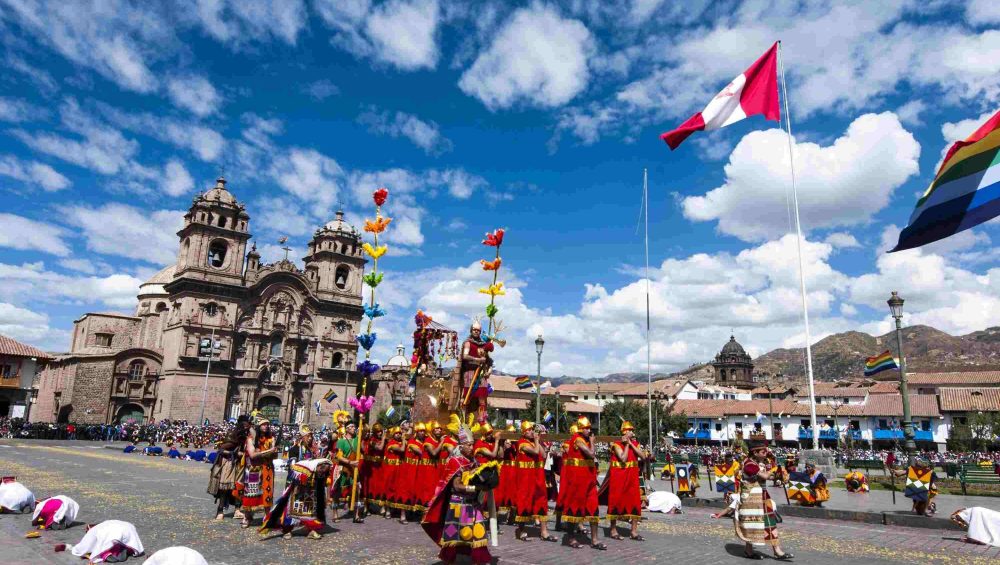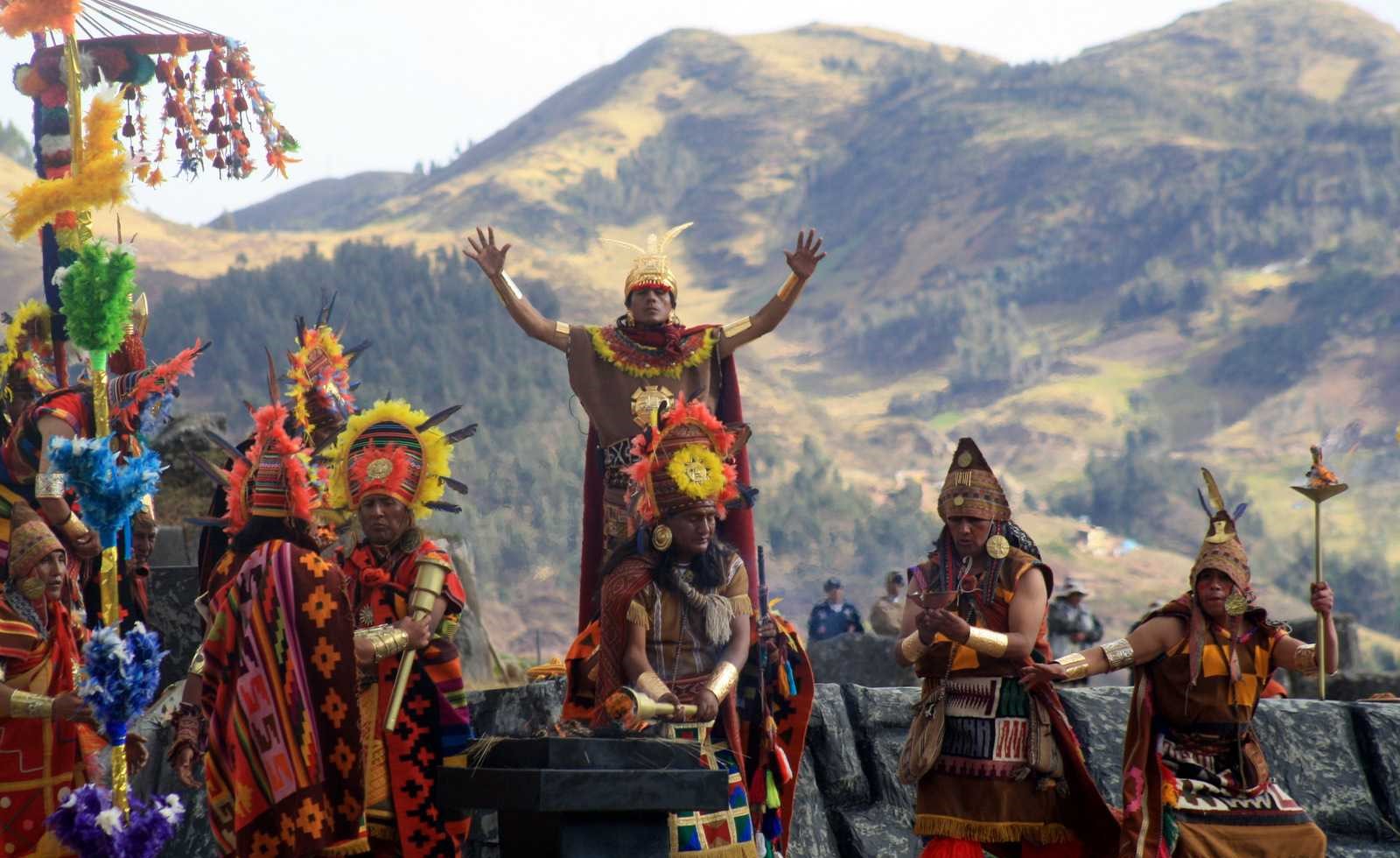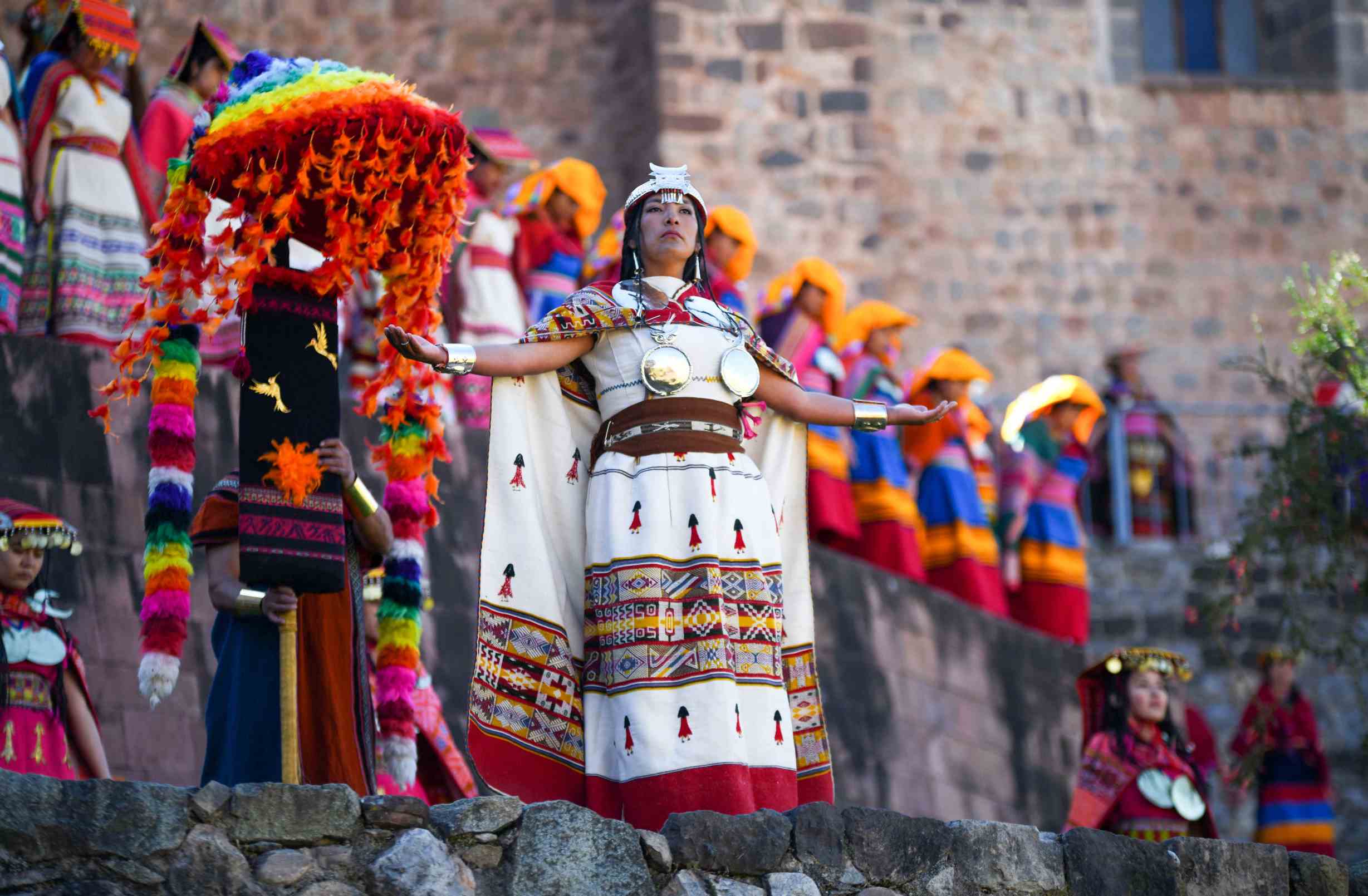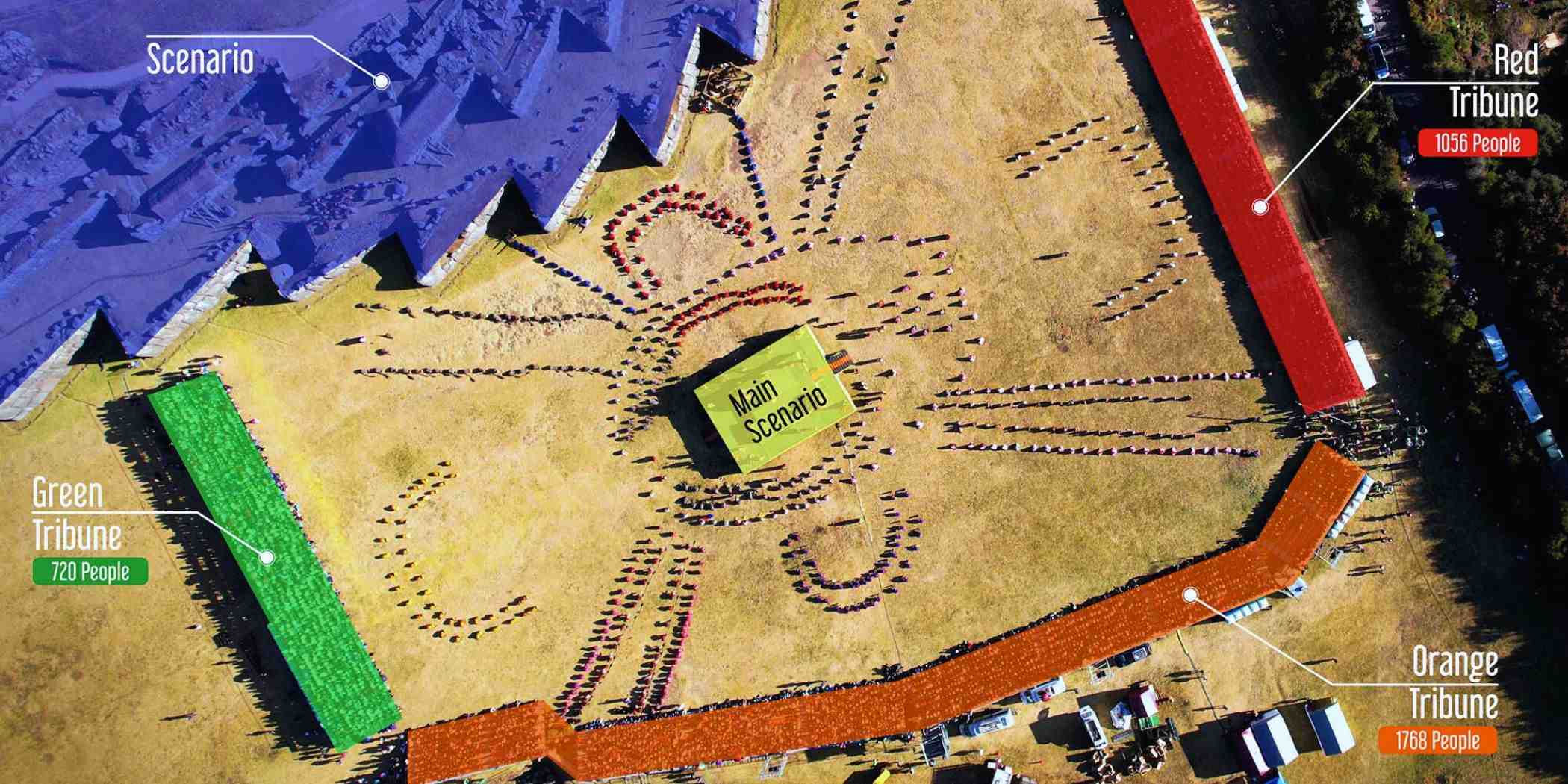Inti Raymi, known as the Sun Festival, is one of the most famous celebrations in Peru and one of the most important cultural events in Latin America. It happens every year in the city of Cusco and brings together thousands of people (both locals and visitors from other countries) who gather to see a colorful and serious show of an old ritual that honors Inti, the Sun god of the ancient Incas.
This festival, which is celebrated every June 24th, marks the winter solstice in the southern part of the world, and with it, the start of a new farming time for the Andean communities. For the Incas, it was the most holy time of the year, because they thanked the Sun for its blessings and asked for its protection for future harvests.
So, come with us and discover all about Inti Raymi: The Sun Festival, from its beginnings in the Inca Empire to its comeback in modern times.
History of Inti Raymi
The history of Inti Raymi tells us about how great the Inca Empire was and how they culturally resisted the changes brought by colonization. This celebration, which was once the most important ritual in the Inca calendar, went through centuries of being forgotten and banned until it was reborn in the 20th century as a symbol of Andean identity and pride.
Next, we will explore its beginnings in the imperial time, the important role of the Sun god (Inti) in Inca culture, and how this festival was forbidden during the colony and then brought back as one of the most amazing cultural events in Peru today.
Beginnings in the Inca Empire
Inti Raymi started in the heart of the Inca Empire, where it was seen as the most important ritual of the ceremonial calendar. Started by the Inca Pachacútec in the 15th century, this big celebration was held during the winter solstice (around June 21st), to thank the Sun god for allowing life and good fortune during the year.
During the Tahuantinsuyo (the Inca Empire), Inti Raymi was not just a religious act, but also a way to strengthen the political power of the Inca, who was seen as the son of the Sun. Thousands of people from all parts of the empire came to Cusco to take part in the ceremony. Offerings were given, people fasted before, and the Inca led a ritual that confirmed his godly connection with Inti (the Sun god). It was also a chance to strengthen the ties between the peoples of the empire and renew their promise to the gods and Pachamama (Mother Earth).
The Importance of the Sun (Inti) in Andean Culture
For the Incas, Inti, the Sun god, was the most important god. He stood for the source of life, heat, and energy, and his light was needed for the growth of crops, especially corn, the main food in the Andes. The Sun was not just a religious figure, but also the center of the Inca cosmic and social system.
The worship of the Sun was shown in temples like the Qorikancha (Sun Temple in Cusco), in sky calendars, and in the planning of farming. So, the Inti Raymi, as a ceremony for this god, showed a deep and holy connection.
Ban in Colonial Times and its Later Recovery in the 20th Century
When the Spanish conquerors arrived in the 16th century, the Inti Raymi (like many other traditions of Andean culture) was banned by the Catholic Church, which saw it as a non-Christian ritual. The celebrations for the Sun were replaced by Christian religious celebrations, and many of the traditions were hidden or changed to survive.
For many centuries, the Inti Raymi disappeared from public life, although some parts of the Andean worldview stayed in a symbolic way in certain rural communities. It wasn’t until 1944 that this ceremony was rebuilt and valued again thanks to the push of Fausto Gutiérrez, a smart person from Cusco, and Humberto Vidal Unda, an actor and writer. They used the writings of Inca Garcilaso de la Vega to create a modern show of the Inca ritual, and that’s how the Inti Raymi as we know it today was born: a cultural event full of mystery, art, and old memories.
Meaning of Inti Raymi
Inti Raymi is not just a folk show or something for tourists; it is a ceremony full of deep meaning, connecting the people of Cusco with their roots, their traditions, and their beliefs. Its meaning lasts through time, staying alive as a real way to show the relationship between people, nature, and the universe.
In the Andean world, everything is connected. The old Incas understood that life depended on the balance between the elements and respect for the forces of nature. The Sun, or Inti, was the center of that harmony, the main being that fed the earth, made crops grow, and allowed life to exist. That’s why, every year, during the winter solstice, they honored it with Inti Raymi Peru: a ceremony that showed the renewal of the cycle of life and energy.
Description of the Event
Inti Raymi, as it is celebrated today, is an amazing show that combines history, art, and spirituality. Every year, thousands of people come to Cusco to see this ceremony that takes the viewer back to the greatness of the Inca Empire, bringing back to life one of its most important traditions. Below are the main parts of this celebration:
Date of Celebration
The Inti Raymi festival takes place every June 24th, aligning with the Southern Hemisphere’s winter solstice, the time when the Sun is most distant from our planet. This date was significant for the Incas, as it symbolized the commencement of a new solar cycle and the beginning of their farming year.
Main People
During the Inti Raymi show, different people play the most important figures of the old empire. Among them are:
- The Inca: He is the main person in the ritual, seen as the son of the Sun. He leads the ceremony, says prayers and gives offerings, and shows the direct link between what is holy and what is on Earth.
- The Coya: The Inca’s wife, she stands for fertility, the moon, and the female part of the sun’s power. She goes with the Inca in the rituals and brings balance to the scene.
- The priests or Willac Umus: They are in charge of understanding the holy signs and guiding the ritual offerings to the Sun and to the Earth Mother (Pachamama).
- The Sinchis and the Generals: Military leaders of the four parts (regions of Tahuantinsuyo) who honor the Inca and bring offerings from their towns.
- Dancers and musicians: They go with the whole ritual with traditional dances and Andean music, showing the cultural variety of the empire.
Rituals
Ritualities
- Greeting the Sun: The Inca appears on stage and says a prayer to the Inti, thanking for life and asking for blessings for the new cycle.
- Reading of Omens: A priest offers coca leaves to the gods and looks at the signs from them and from the holy fire.
- Procession of the regions: Groups representing the four regions of the Inca Empire (Chinchaysuyo, Antisuyo, Contisuyo, and Collasuyo) parade before the Inca. They perform dances and present offerings, demonstrating the unified nature of Tahuantinsuyo.
- Pretending to sacrifice a llama: Even though they don’t really sacrifice an animal anymore, they show the act in a symbolic way.
- Ceremony of the holy fire: A new fire is lit as a symbol of new beginnings and is shared with the people there.
- Parade of the people and farewell to the Sun: It ends with a big artistic display where the people leave in a procession, while thanks are given to the Sun for listening to the people’s requests.
Main Places Where the Event Takes Place
The Inti Raymi, in its modern version, happens in three important places in the city of Cusco. Each of these places has a lot of symbolic and historical meaning, and together they help to show again the ritual journey that the Incas did during the original ceremony. These are the 3 important places where this celebration takes place:
1. Qorikancha (Temple of the Sun)
The ceremony starts at the Qorikancha, one of the most sacred temples of the Inca Empire. In old times, this place held the main altars for the god Inti and was covered with gold sheets that reflected the sunlight. Today, the temple is part of the Santo Domingo Convent, built on its foundations during the time of colonization.
In this first place, the Inca makes his first public appearance, coming out from the top of the temple to say a prayer to the Sun. The people gathered in the open area receive his greeting with great respect.
2. Main Square of Cusco
From the Qorikancha, the ceremony continues to the Main Square, known in Inca times as Huacaypata, which means “plaza of tears” or “sacred place”. This space was the political, ceremonial, and military heart of the Inca Empire, where the main celebrations of the Andean calendar were held.
In the modern show, the second part of the ritual takes place here. Groups from the four regions of Tahuantinsuyo arrive dancing and paying tribute to the Inca. The performance includes traditional music, colorful clothes, and an impressive display of actors and dancers.
3. Sacsayhuaman
The main event of Inti Raymi happens at the Sacsayhuaman fortress, a big old site on a hill to the north of Cusco. Here, the main ceremony takes place, where the Inca gives his respect to the Sun god. There is a symbolic show of sacrificing a llama, they tell what will happen in the next year, and they light the holy fire. It is the most awaited and serious part of the event, where more than 700 actors and musicians take part, bringing to life one of the most amazing shows in the Peruvian cultural calendar.
The Inti Raymi Festival Today
Today, Inti Raymi is a celebration that shows the Andean identity, a way to be proud of the culture that brings together thousands of people every June 24th in Cusco. Since it started again in 1944, the ceremony has grown to be one of the most important cultural events in Peru, and one of the biggest in Latin America.
The modern Inti Raymi Peru keeps the ritual structure of the original, based on the writings of Inca Garcilaso de la Vega, but changed as a stage show with theater, music, and dance. Local groups like the Municipality of Cusco, the Inti Raymi Committee, and the Ministry of Culture organize it. Every year they work to put on a perfect ceremony that is true to the old spirit.
Interesting Facts and Highlights
The Inti Raymi festival has many interesting details, from how they pick the actor who plays the Inca, to the huge planning it takes to organize it. This event shows deep respect for traditions and the shared effort to keep them alive. Here are some interesting facts that will help you understand better how big and rich this festival is:
- How is the Inca chosen each year?The role of the Inca is very important in the ceremony and is not chosen randomly. Every year, they carefully pick the actor who will play the Inca, the Son of the Sun. Usually, this role is taken by an actor from Cusco with experience in theater, who knows the Quechua language well (since the speeches are said in this old language), and has a strong stage presence.The choice also looks at physical things: the actor should have Andean features, be tall, and have a strong voice that can be heard in open spaces (in many cases, the same actor has been chosen in several years because of their great acting). Once chosen, the Inca goes through intense preparation that includes rehearsals, posture training, speaking clearly, and learning about the rituals.
- How many people take part in the show?Inti Raymi is a huge show that has more than 700 actors, musicians, and dancers. Most of them are local artists and students from art and theater schools in Cusco. They practice for weeks to show the movements, clothes, and dances based on historical records.Besides them, there are organizers, sound people, costume makers, dance teachers, makeup artists, and security staff. The whole city gets involved to make the event happen, making Inti Raymi one of the biggest cultural shows in the country.
- Why is it celebrated at the solstice?Inti Raymi is celebrated during the winter solstice in the southern part of the world, which happens around June 21st. For the Incas, this time was the shortest day of the year and meant the sun’s cycle was starting again. It was a very important date in the Andean farming calendar because it marked the start of a new time for planting and good growth.Choosing the solstice as the date to honor the Sun god was not by chance: the Incas knew a lot about the stars and lined up their temples and rituals with the sky’s cycles. Inti Raymi, celebrated on June 24th in its modern form, keeps that link with the sun’s calendar, reminding us that, for the old people of the Andes, nature was the main guide for time, life, and spirit.
Tips for Going to Inti Raymi
Experiencing Inti Raymi in Cusco is a special and very exciting thing. But to enjoy it the most, it’s important to plan ahead and keep some simple things in mind. Here are some main tips to make your visit one to remember:
How to Plan Your Visit
- Book early: June is a busy time in Cusco because of Inti Raymi and the Anniversary Month. Hotels, flights, and tours fill up fast, so it’s best to book at least three months before.
- Arrive a few days before: June 24th is the main day, but there are cultural activities, fairs, and festivals in the city in the days before. Also, arriving early will help you get used to the high place (Cusco is at 11,150 feet above sea level).
- Get ready for the weather: The weather in June is cold, especially in the mornings and evenings, even though it’s very sunny during the day. Bring warm clothes that you can layer, sunscreen, a hat, and sunglasses.
- Getting around and safety: During Inti Raymi, many streets in the Cusco Historic Center are closed to traffic. It’s best to walk and be careful with your things, as there will be many people around.
Tickets for Inti Raymi
The event has three stages, but only one needs a paid ticket:
- Qorikancha and Plaza de Armas: It’s free to enter. However, because there are many people, it’s a good idea to arrive very early to get a good spot. Bring a blanket or cushion if you plan to sit on the ground.
- Sacsayhuamán: This is the main stage where the most important part of the ceremony happens. Here, you do need a ticket that you can buy ahead of time through authorized travel agencies, the Municipality of Cusco, or official websites. There are areas with numbered seats, and the prices change depending on where you sit.
Extra Tip: Some agencies offer packages that include transportation, guides, and a packed lunch. It’s an easy option if you want to avoid planning on your own, but you can also get there by yourself by walking or using local transportation.
Layout of the Inti Raymi Stands in Sacsayhuamán
The VIP area of Inti Raymi Cusco has three stands that offer the best views to enjoy this amazing ceremony.
- Orange Stand: This is the most popular and one of the favorites of the people who come, because it is right in front of the Ushnu, the main stage. From this spot, you can clearly see every moment of the show. It can hold 1,768 people.
- Red Stand: It also offers a great view and can hold up to 810 people.
- Green Stand: With space for 1,188 people, it is another good choice to closely follow how the event unfolds.
No matter which stand you choose, all of them let you see the show very well, because the Sacsayhuaman field is a large, open, and well-arranged space, perfect for seeing every detail of this celebration.




